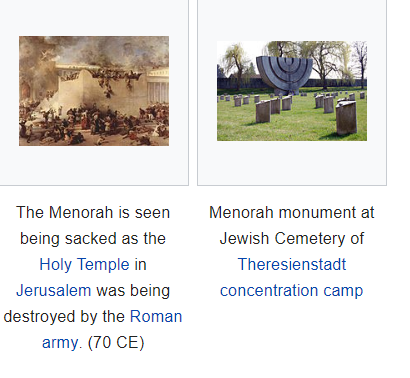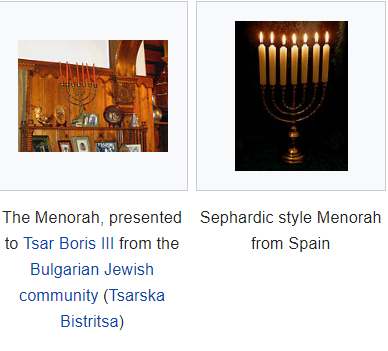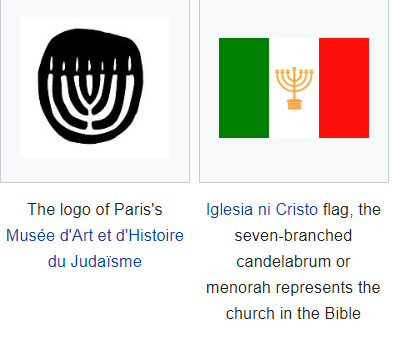|
PART 1 T O P I C |
|
|
|
|
|
|
|
|
|
|
|
|
|
|
|
|
|
|
|
|
|
|
|
CLICK BUTTON |
|
|
|
|
|
|
|
|
|
Israel |
|
|
|
|
|
|
|
ISRAEL - PALESTINIAN |
|
|
|
|
|
|
JewishWikipedia.info
The flag of Morocco. First raised on November 17, 1915. It has a red background with the “Seal of Solomon” consisting of a five-point star at its center.
See Wikipedia for ‘seal of Solomon
See Wikipedia for ‘Flag of Morocco’
THE
STORY OF THE JEWISH PEOPLE
The Star of David (Magen David) was adopted as the central symbol
of its flag, by the State of Israel, when it was created in 1948.
It is the heroic symbol, with an emotional history, of the Jewish people
Magen David Adom is the name given to the Israel Red Cross
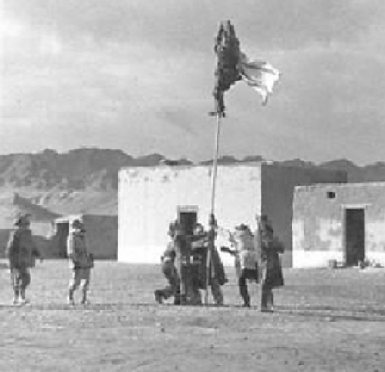
FLAG OF ISRAEL
New World Encyclopedia
The Star of David is a widely recognized symbol of Judaism, named after King David of ancient Israel, which consists of two interlocking equilateral triangles. According to legend, the Star of David may have originated from the Shield of David (known as the Magen David in Hebrew, מָגֵן דָּוִד). It may also have evolved from the mysterious Seal of Solomon (five-pointed star) that was used in the ancient world as a talisman. However, the star's pedigree as a common Jewish symbol did not become widespread until the late Middle Ages. Since that time, it has become one of the defining symbols of Judaism along with the more ancient symbol of the Menorah. The star has been used to adorn the cover of the Torah, and it is found on Jewish synagogues and tombstones.
Meaning
Other interpretations of the meaning of the Star of David.
- Most frequently, the star is associated with the number seven (derived from the six points plus the center). This number has considerable religious significance in Judaism, which can be noted in several examples including the six days of Creation plus the seventh day of rest, as well as the Seven Archangels of God. In the same vein, the Star of David may have evolved as an abstract symbol of the Menorah (the more traditional symbol for Judaism that once stood in the Temple of Jerusalem), due to its association with light as well as its geometric organization into 3+3+1, which corresponds to the seven branches of the Menorah.
- The Star of David locates its meaning in the name David itself. In Hebrew spelling (דוד), David contains only three characters, two of which are "D" (or "Dalet," in Hebrew). In ancient times, this letter was written in a form much like a triangle, similar to the Greek letter Delta (Δ). Thus, the symbol may have been a family crest formed by flipping and juxtaposing the two most prominent letters in the name.
- The hexagram is also known as the "King's Star" in astrological circles, and was an important astrological symbol in Zoroastrianism, which may represent the astrological chart at the time of David's birth or anointment as king.
- A popular folk story tells that the Star of David is literally modeled after the shield of the young Israelite warrior David (later to be King David). In order to save metal, the shield was not made of metal but of leather spanned across the simplest frame that would hold the round shield: two interlocking triangles. However, no reliable historical evidence for this alleged origin exists.
The earliest archaeological evidence for the Jewish use of the symbol comes from an inscription attributed to Joshua ben Asayahu in the late seventh century B.C.E.: Sidon. The earliest extant Jewish text to mention it is the Eshkol Ha-Kofer by a Karaite named Judah Hadassi, from the twelfth century C.E., which states: "Seven names of angels precede the mezuzah: Michael, Gabriel, etc. ... Tetragrammaton protect you! And likewise the sign, called the 'Shield of David', is placed beside the name of each angel.
In medieval Judaism, popular Kabbalah made use of the Star of David, arranging the Ten Sephiroth, or spheres, in it, and placing it on amulets. Kabbalistically, the Star/Shield of David symbolizes the six directions of space plus the center, under the influence of the description of space found in the Sefer Yetsira: Up, Down, East, West, South, North, and Center. Congruently, under the influence of the Zohar, it represents the Six Sefirot of the Male (Zeir Anpin) united with the Seventh Sefirot of the Female (Nekuva). However, the sign is nowhere to be found in classical kabbalistic texts themselves, such as the Zohar and the like. Therefore, its use as a sefirotic diagram in amulets is more likely a reinterpretation of a preexisting magical symbol.
It has been suggested that Isaac Luria influenced the Star of David becoming a national Jewish emblem by teaching that the elements of the plate for the Seder evening have to be placed in the order of the hexagram, above the three sefirot "Crown, wisdom, and insight, below the other seven."Eventually, the hexagram was employed as an architectural ornament on synagogues, as it is, for example, on the cathedrals of Brandenburg and Stendal, and on the Marktkirche at Hanover.
The earliest Jewish literary source that mentions the Shield of David is the Eshkol Ha-Kofer by Judah Hadassi from the mid-twelfth century C.E., where seven shields are used in an amulet for a mezuzah.
A manuscript TaNaK dated 1307 and belonging to Rabbi Yosef bar Yehuda ben Marvas from Toledo, Spain, was decorated with a Shield of David.
In 1354, King Charles IV of Bohemia prescribed for the Jews of Prague a red flag depicting both David's shield and Solomon's seal. Later, it is recorded that the Jews met King Matthias (Mathios Kuruvenus) of Ofen (Budapest, Hungary) in 1460 with another red flag showing two pentagrams with two golden stars. The pentagram, therefore, may also have been used among the Jews. It occurs in a manuscript as early as the year 1073.
In a Hebrew prayer book, printed in Prague in 1512, a large Shield of David appears on the cover. In the colophon is written: "Each man beneath his flag according to the house of their fathers...and he will merit to bestow a bountiful gift on anyone who grasps the Shield of David." In 1592, Mordechai Maizel was allowed to affix "a flag of King David, similar to that located on the Main Synagogue" to his synagogue in Prague. In 1648, the Jews of Prague were again allowed a flag, in acknowledgment of their part in defending the city against the Swedes. On a red background was a yellow Shield of David, in the center of which was a Swedish star.[4]
The Star of David can also be found on the tombstones of Jews going back hundreds of years in Europe, as it became accepted as the universal symbol of the Jewish people. Following Jewish emancipation after the French Revolution, Jewish communities chose the Star of David to represent themselves, comparable to the cross used by most Christians.
Some Orthodox Jewish groups, however, reject the use of the hexagram Star of David because of its association with magic and the occult and they do not recognize it as a Jewish symbol.
Some Haredi groups, such as Neturei Karta and Satmar, reject it because they associate it with Zionism. Nevertheless, many Modern Orthodox synagogues, and many synagogues of other Jewish movements, have the Israeli flag with the Star of David prominently displayed at the front of the synagogues near the Ark containing the Torah scrolls.
Mythology
Jewish lore links the Star of David symbol to the Seal of Solomon, the magical signet ring used by King Solomon to control demons and spirits.
Scholars once speculated that the hexagram may be a relic from Ancient Egyptian religious practices, adopted by Jews engaged in the occult and syncretism as early as the era of King Solomon. However such claims are unlikely due to the scarcity of evidence in Egyptian religious practices B.C.E. Where Hellenistic Gnostics and Egyptians did use pentagrams in their amulets (such as the "pentalpha" symbol), they did not use hexagrams, which is notably absent from the ancient papyri.
Jewish lore also links the symbol to a magic shield supposedly owned by King David that protected him from enemies. The Shield of David is not mentioned in ancient rabbinic literature. A supposed “David's Shield,” however, has recently been noted on a Jewish tombstone at Taranto, in Southern Italy, which may date as early as the third century C.E. Likewise, a stone bearing the shield from the arch of a third or fourth century synagogue in the Galilee was found.
Use by the Nazis - The Jude Badge
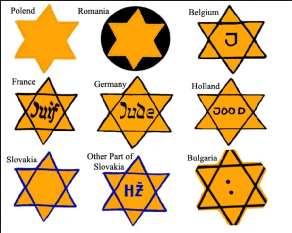 A Star of David, often yellow, was used by the Nazis during the Holocaust as a method of identifying Jews. After the German invasion of Poland in 1939, there were initially different local decrees forcing Jews to wear a distinct sign (e.g. in the General Government, a white armband with a blue Star of David on it, in the Warthegau a yellow badge in the form of a Star of David on the right side of the breast and on the back.)[6] The requirement to wear the Star of David with the word Jude (German for Jew) inscribed was then extended to all Jews over the age of six in the Reich and the Protectorate of Bohemia and Moravia by a decree issued on September 1, 1941 and signed by Reinhard Heydrich. It was gradually introduced in other German-occupied areas, where local words were used (e.g. Juif in French, Jood in Dutch).[7]
A Star of David, often yellow, was used by the Nazis during the Holocaust as a method of identifying Jews. After the German invasion of Poland in 1939, there were initially different local decrees forcing Jews to wear a distinct sign (e.g. in the General Government, a white armband with a blue Star of David on it, in the Warthegau a yellow badge in the form of a Star of David on the right side of the breast and on the back.)[6] The requirement to wear the Star of David with the word Jude (German for Jew) inscribed was then extended to all Jews over the age of six in the Reich and the Protectorate of Bohemia and Moravia by a decree issued on September 1, 1941 and signed by Reinhard Heydrich. It was gradually introduced in other German-occupied areas, where local words were used (e.g. Juif in French, Jood in Dutch).[7]
Jewish inmates in concentration camps were later forced to wear similar Nazi concentration camp badges.
Modern Usage
The Star of David continues to be a heroic symbol for many modern Jews, and it has been adopted on the flag of Israel with the creation of the modern State of Israel in 1948.
In modern Israel, the Star of David is used by the Magen David Adom (MDA) (Red Shield of David), Israel's only official emergency medical, disaster, and ambulance service. It is an official member of the International Committee of the Red Cross.
STAR OF DAVID
From the Holocaust to the Israeli flag, what is the deeper meaning of this six-pointed Jewish symbol?
Aish, Rabbi Shraga Simmons, June 22, 2002
TODAY
The Star of David has become a premier Jewish symbol. This six-pointed star (hexagram), made of two interlocking triangles, can be found on mezuzahs, menorahs, tallis bags and kipot. Ambulances in Israel bear the sign of the "Red Star of David," and the flag of Israel has a blue Star of David planted squarely in the center.
What is the origin of this six-pointed symbol?
The six points symbolize God's rule over the universe in all six directions.
Through the Jewish people's long and often difficult history, we have come to the realization that our only hope is to place our trust in God. The six points of the Star of David symbolize God's rule over the universe in all six directions: north, south, east, west, up and down.
Originally, the Hebrew name Magen David ― literally "Shield of David" ― poetically referred to God. It acknowledges that our military hero, King David, did not win by his own might, but by the support of the Almighty. This is also alluded to in the third blessing after the Haftorah reading on Shabbat: "Blessed are you God, Shield of David."
Suggested Symbolism
So when did the Star of David become adopted as a Jewish symbol? It is not referred to in the Bible or the Talmud, and was apparently adopted later in Jewish history. Still by exploring some various explanations on the meaning behind the Star of David, we can appreciate deep Jewish concepts.
One idea is that a six-pointed star receives form and substance from its solid center. This inner core represents the spiritual dimension, surrounded by the six universal directions. (A similar idea applies to Shabbat ― the seventh day which gives balance and perspective to the six weekdays.)
In Kabbalah, the two triangles represent the dichotomies inherent in man: good vs. evil, spiritual vs. physical, etc. The two triangles may also represent the reciprocal relationship between the Jewish people and God. The triangle pointing "up" symbolizes our good deeds which go up to heaven, and then activate a flow of goodness back down to the world, symbolized by the triangle pointing down.
Some note that the Star of David is a complicated interlocking figure which has not six (hexogram) but rather 12 (dodecogram) sides. One can consider it as composed of two overlapping triangles or as composed of six smaller triangles emerging from a central hexogram. Like the Jewish people, the star has 12 sides, representing the 12 tribes of Israel.
A more practical theory is that during the Bar Kochba rebellion (first century), a new technology was developed for shields using the inherent stability of the triangle. Behind the shield were two interlocking triangles, forming a hexagonal pattern of support points. (Buckminster Fuller showed how strong triangle-based designs are with his geodesics.)
One cynical suggestion is that the Star of David is an appropriate symbol for the internal strife that often afflicts Jewish nation: two triangles pointing in opposite directions!
The Star of David was a sad symbol of the Holocaust, when the Nazis forced Jews to wear an identifying yellow star. Actually, Jews were forced to wear special badges during the Middle Ages, both by Muslim and Christian authorities, and even in Israel under the Ottoman Empire.
So whether it is a blue star waving proudly on a flag, or a gold star adorning a synagogue's entrance, the Star of David stands as a reminder that for the Jewish people... in God we trust.
MENORAH (MENORA) CANDELABRUM
Wikipedia
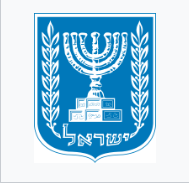
The Coat of Arms of Israel shows a menorah surrounded by an olive branch on each side and the writing "ישראל" (Israel) based on its depiction on the Arch of Titus.
The Emblem of the State of Israel (Hebrew: סמל מדינת ישראל, translit. Semel Medinat Yisra'el; Arabic: شعار دولة إسرائيل, translit. shiear dawlat 'iisrayiyl) shows a menorah surrounded by an olive branch on each side, and the writing "ישראל" (Hebrew for Israel) below it. Most commonly light blue and white, the coat of arms does appear in different colour combinations depending on the use (see below).
HISTORY
The State of Israel adopted the symbol after a design competition held in 1948. The design is based on the winning entry submitted by Gabriel and Maxim Shamir's proposal, with elements taken from other submissions, including entries from Oteh Walisch, W. Struski, Itamar David, Yerachmiel Schechter, and Willie Wind, whose entry won the first design competition.
SYMBOLISM
The image used on the emblem is based on a depiction of the menorah on the Arch of Titus. The menorah was used in the ancient Temple in Jerusalem and has been a symbol of Judaism since ancient times. It symbolizes universal enlightenment, based on what is written in Isaiah 60: "Nations will come to your light, and kings to the brightness of your dawn".
The emblem may also be based on the vision of the biblical prophet Zechariah, chapter 4, where he describes seeing a menorah flanked by two olive trees, one on each side.
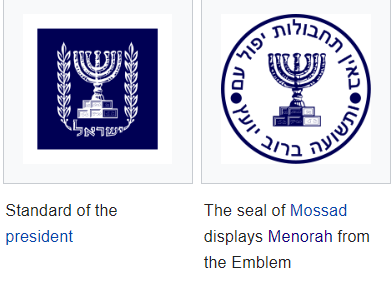
Menorah, also spelled menora, multibranched candelabra, used in the religious rituals of Judaism, that has been an important symbol in both ancient and modern Israel. The seven-branched menorah was originally found in the wilderness sanctuary and then later in the Temple in Jerusalem and was a popular motif of religious art in antiquity. An eight-branched menorah modeled after the Temple menorah is used by Jews in rites during the eight-day festival of Hanukkah.
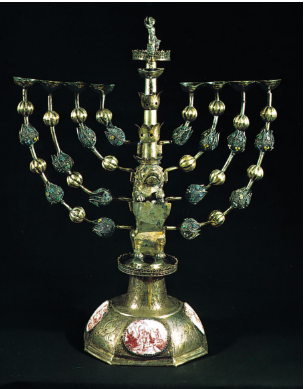
Hanukkah menorah, silver with enamel medallions, by Johann Adam Boller,
early 18th century.
Jewish Museum, New York City
The menorah is first mentioned in the biblical book of Exodus (25:31–40), according to which the design of the lamp was revealed to Moses by God on Mount Sinai. The candlestick was to be forged out of a single piece of gold and was to have six branches, “three out of one side, and three out of the other” (Exodus 25:31). The cup atop the central shaft, which is somewhat elevated to signify the Sabbath, was flanked by three lights on each side. It was forged by the craftsman Bezalel and put in the Tabernacle, and its cups in the shape of flower blossoms suggested the tree of life. The Temple of Solomon, according to the book of Kings, had 10 golden candelabras, 5 on each side of the entrance to the inner sanctuary. The Second Temple, built after the Jews returned from exile in Babylon, contained one menorah that was seized in 169 BCE by Antiochus IV Epiphanes when he desecrated the Temple. Judas Maccabeus ordered construction of a new seven-branched candelabra, which he placed in the Temple after the desecration by Antiochus. The menorah disappeared after the destruction of the Second Temple in 70 CE; according to Josephus, the menorah was displayed during the Roman triumphal march, but the menorah displayed on the Arch of Titus is no longer thought to be the Temple candelabra. Although the menorah disappeared and the Talmud forbade its reconstruction, it became a popular symbol signifying Judaism. Representations of the menorah decorated tombs and the walls and floors of the synagogues. During the early modern period the menorah as symbol gave way to the Star of David, but in the 19th century it was adopted as the symbol of the Zionists. The seven-branched candelabra depicted on the Arch of Titus became the official emblem of the state of Israel in the 20th century.
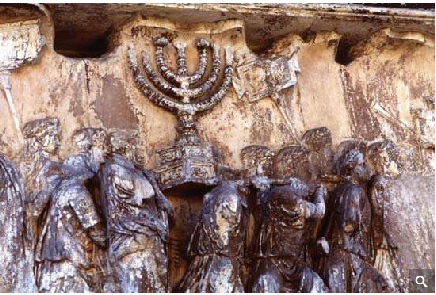
Romaan soldiers carrying a menorah, detail of a relief on the Arch of Titus 81CE
.
The Hanukkah lamp is an eight-branched imitation of the original Tabernacle menorah that is used to celebrate the rededication of the Second Temple. The lamp has taken many forms through the ages, but its essential feature has been eight receptacles for oil or candles and a holder for the shammash (“servant”) light, which is used for kindling the other lights. During each night of Hanukkah, candles are inserted into the menorah from right to left but are lighted from left to right. The lamp is displayed in a highly visible location, and depictions of it are often found on public buildings, synagogues, and private homes.
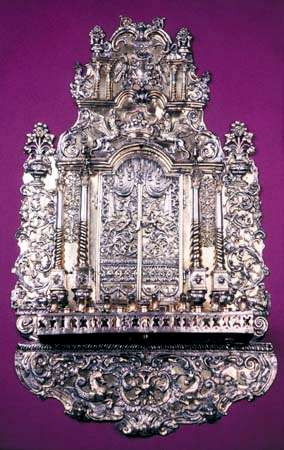
Hanukkah lamp
Hanukkah lamp from Brody, Galicia (now in Ukraine), 1787; in the Jewish Museum, New York City.
Graphic House/Encyclopædia Britannica, Inc.
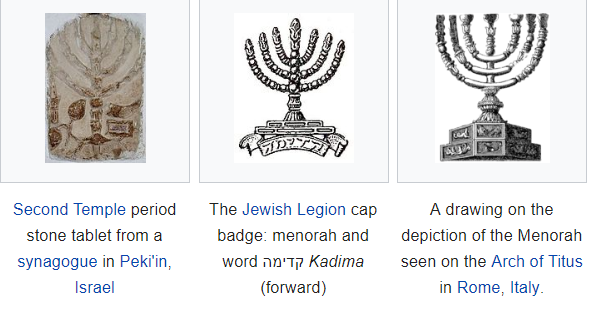
THE STAR OF DAVID
in the oldest surviving complete copy of the Masoretic text,
the Leningrad Codex,
dated 1008.
STAR OF DAVID
The flag of Israel today
STAR OF DAVID
By order of the Nazis was worn by Jews to show their religion.
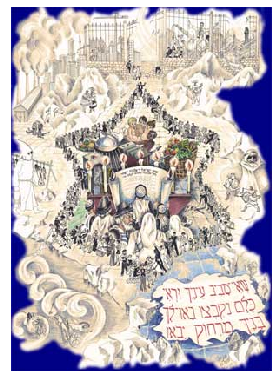 This drawing by Dr. Semion Natliashvili depicts the modern ingathering of the Jewish People after 2,000 years of Diaspora.
This drawing by Dr. Semion Natliashvili depicts the modern ingathering of the Jewish People after 2,000 years of Diaspora.
The center image of the picture shows young and old man attired in prayer shawl and reading from a Torah scroll that has united the Jewish People. The written portion shows Shema Yisrael Adonay Eloheynu Adonay Echad (Hear, Israel, the Lord is our G-d, the Lord is One).
The Star of David symbolizes the gathering of the Jewish People from all corners of the world including Georgia (country of birth of the artist), Morocco, Russia, America, China, Ethiopia, Europe and other countries joining together in dance and celebration. Other images inside the star symbolize modern Israeli industry, agriculture and military. The images on the margins of the picture symbolize the major threats that the Jewish People faced in Exile starting from the Exodus from Egypt, followed by Romans, Arabs and culminating in the gas-chambers of the Holocaust in Europe.
THE STAR OF DAVID
IS THE ONLY NATIONAL FLAG
THAT HAS THE LETTERS
OF THE
NATIONAL LANGUAGE (HEBREW) BUILT IN.
INK FLAG BEING RAISED OVER EILAT
Ynet News 3.11.2015
The defense ministry released Tuesday new photos from the IDF archives of the raising of the Ink Flag, a historic moment in which IDF soldiers raised a handmade Israeli flag painted with ink over the Umm Al-Rashrash police station in 1949 to mark the capture of Eilat. The photos were released on the occasion of the 66th anniversary of Operation Uvda, in which IDF troops conquered the southern Negev desert.
Operation Uvda was the last campaign conducted by the IDF during the War of Independence, and the now-famous moment of the raising of the flag is viewed as the peak of the operation. At the beginning of the operation, the Negev Brigade and Golani Brigade were dispatched towards Eilat. Five days later, Negev Brigade forces arrived at the abandoned police station at Umm Rashrash (where the city of Eilat was later built).
When Nahum Sarig, who was the commander of the Negev Brigade, noticed that the brigade did not have an Israeli flag on hand, he ordered his soldiers to make a handmade one. The Brigade Secretary, Pua'ah Er'el, found a white bed sheet and drew the flag, using ink.
The famous photos show Israeli forces flying the flag over the police station at Umm Al-Rashrash. The flag was raised by Avraham Adan, company commander of the 8th Battalion of the Negev Brigade. Two hours later, Golani soldiers arrived at the area and replaced the ink flag with a standard flag.
Yohanan Elyashuv, who is today 84-years-old, was among those who participated in the raising of the flag. The moment in which the flag was raised is engraved in his memory. "I was 17 and a half, and I remember everything," he says. "I'm shown standing in one of the pictures in the middle, with a big coat."
Elyashuv recalls that famous day, 66 years ago: "We were in Be'er Sheva, and we went down to the south. There was an Egyptian police station there and a border control station. They were confused, and we gave them several cans of sardines. The Egyptian police officers said that if we cross through the side, we won't have to pay, and that's how we crossed into Eilat without a single gun shot fired."
Elyashuv also remembers that "they warned me of mines, but I wasn't afraid. I already stepped on a mine in the past. I ended up driving the car and there weren't any mines. There was also a competition between the two brigades regarding who would arrive first to hang the flag, and we arrived first. Some say the flag was drawn in Be'er Sheva, some say in Eilat. What's certain is that the path leading to that moment was interesting."

A GIFT FROM THE PHILIPPINES -
THE WORLD'S LARGEST
FLAG OF ISRAEL
Infolivetvenglish 2007 (2,16)
Commemorating 50 years of relations between the Philippines and Israel. Flags of Israel and the Philippines were made,
each the size of two football fields.
The 2007 World Record Flags were airlifted from the Philippines and unveiled at an airfield near the
historic mountain fortress of Masada. 11/26/07
The flag, manufactured in the Philippines, measured 660 by 100 meters
(2,170 ft × 330 ft)
and weighed 5.2 tonnes (5.7 short tons),
breaking the previous record.
It was measured and verified
by representatives
of the Guinness Book of Records.
The project was initiated by a businesswoman and nun from the Philippines,
Sister Grace Galindez-Gupana.
THE BIGGEST
ISRAELI FLAG MURAL
IN THE WORLD
Tal Agassi 2013 (2.32)
THE LARGEST
ISRAELI FLAG MURAL
IN THE WORLD, EILAT
Painted on a concrete hangar in
Eilat’s naval base
it covers 3,600 square meters
to celebrate the 65th anniversary
of Israel's Independence.
Using a combination of light and shadow,
the flag can be seen from the shores
of the Gulf of Eilat and nearby cities.
The flag,
30 meters high and 120 meters long,
was painted to appear
as if blowing in the wind.
The flag was an initiative of
the Mayor of Eilat, Meir Yitzhak Halevi.
Tambour International,
a leading paint manufacturing
and marketing company,
donated 2,800 liters of paint
to ensure the project’s success.
THE WORLD'S LARGEST
FLAG MURAL,
EILAT, ISRAEL
completed in Eilat
Joseph Wouk 2014 (1.35)
STAR OF DAVID - FLAG OF ISRAEL - MAGEN DAVID
MENORAH - NATIONAL SYMBOLS - FLAGS
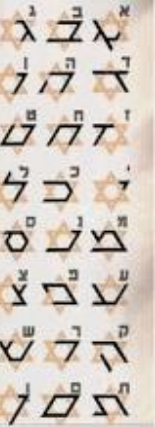
INCREDIBLE

